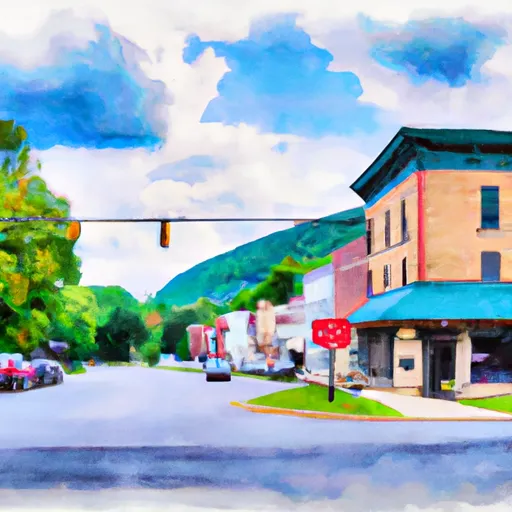-
 Snoflo Premium
Snoflo Premium
Get unlimited access to all our content
With no Ad interruptions! - Start Your Free Trial Login with existing account
Marble
Eden Index
Climate
8.4
•
Recreation
3.8
•
Community
•
Safeguard
4.7/10

Marble, Pennsylvania is a picturesque town nestled in the heart of the state. Known for its moderate climate, the town experiences all four seasons with pleasant temperatures throughout the year. Summers are warm with average temperatures ranging from 70°F to 85°F, while winters can be chilly with temperatures averaging between 20°F and 40°F. The region receives moderate rainfall throughout the year, making it ideal for lush vegetation and diverse wildlife.
Hydrologically, Marble benefits from its proximity to various water bodies. The town is blessed with several rivers, streams, and lakes, which provide ample opportunities for water-based activities like fishing, boating, and swimming. The local waterways are known for their pristine quality and are home to a variety of fish species, making it a haven for fishing enthusiasts.
Marble offers a wealth of outdoor recreation opportunities for nature lovers. The town is surrounded by stunning natural landscapes, including nearby forests and parks. Hiking and camping are popular activities, with numerous trails and camping sites available for visitors. The area is also renowned for its abundant wildlife, making it a great destination for birdwatching and nature photography. Additionally, Marble hosts seasonal events and festivals that showcase the town's vibrant outdoor culture, attracting visitors from far and wide.
What is the Eden Index?
The Snoflo Eden Index serves as a comprehensive rating system for regions, evaluating their desirability through a holistic assessment of climate health, outdoor recreation opportunities, and natural disaster risk, acknowledging the profound impact of these factors on livability and well-being.
Climate Health Indicator (CHI): 8.4
Marble receives approximately
1185mm of rain per year,
with humidity levels near 78%
and air temperatures averaging around
9°C.
Marble has a plant hardyness factor of
5, meaning
plants and agriculture in this region thrive during a short period during spring and early summer. Most
plants will die off during the colder winter months.
By considering the ideal temperature range, reliable water supplies, clean air, and stable seasonal rain or snowpacks, the Climate Health Indicator (CHI) underscores the significance of a healthy climate as the foundation for quality living.
A healthy climate is paramount for ensuring a high quality of life and livability in a region, fostering both physical well-being and environmental harmony. This can be characterized by ideal temperatures, reliable access to water supplies, clean air, and consistent seasonal rain or snowpacks.
Weather Forecast
Streamflow Conditions
Allegheny
Area Rivers
Allegheny
Snowpack Depths
Allegheny
Reservoir Storage Capacity
Allegheny
Groundwater Levels
Recreational Opportunity Index (ROI): 3.8
The Recreational Opportunity Index (ROI) recognizes the value of outdoor recreational options, such as parks, hiking trails, camping sites, and fishing spots, while acknowledging that climate plays a pivotal role in ensuring the comfort and consistency of these experiences.
Access to outdoor recreational opportunities, encompassing activities such as parks, hiking, camping, and fishing, is crucial for overall well-being, and the climate plays a pivotal role in enabling and enhancing these experiences, ensuring that individuals can engage in nature-based activities comfortably and consistently.
Camping Areas
| Campground | Campsites | Reservations | Toilets | Showers | Elevation |
|---|---|---|---|---|---|
| Keystone State Park | None | 1,079 ft | |||
| Buckaloons Rec Area | 132 | 1,164 ft | |||
| Tionesta Rec Area - Tionesta Lake | None | 1,078 ft | |||
| Crooked Creek Recreation Area | None | 969 ft | |||
| Redbank Valley Municipal Park | None | 1,135 ft | |||
| Kellettville Rec Area Tionesta Lake | None | 1,155 ft | |||
| Hearts Content Rec Area | 36 | 1,903 ft | |||
| Lake Erie State Park | None | 623 ft | |||
| Milton Loop | None | 1,150 ft | |||
| Bush | None | 957 ft |
Nearby Ski Areas
Catastrophe Safeguard Index (CSI):
The Catastrophe Safeguard Index (CSI) recognizes that natural disaster risk, encompassing floods, fires, hurricanes, and tornadoes, can drastically affect safety and the overall appeal of an area.
The level of natural disaster risk in a region significantly affects safety and the overall livability, with climate change amplifying these risks by potentially increasing the frequency and intensity of events like floods, fires, hurricanes, and tornadoes, thereby posing substantial challenges to community resilience and well-being.
Community Resilience Indicator (CRI):
The Community Resilience Indicator (CRI) recognizes that education, healthcare, and socioeconomics are crucial to the well-being of a region. The CRI acknowledges the profound impact of these elements on residents' overall quality of life. By evaluating educational resources, healthcare accessibility, and economic inclusivity, the index captures the essential aspects that contribute to a thriving community, fostering resident satisfaction, equity, and social cohesion.

